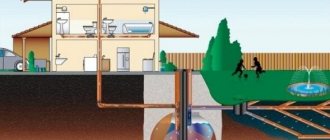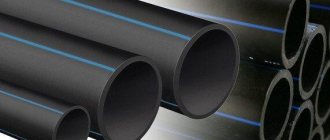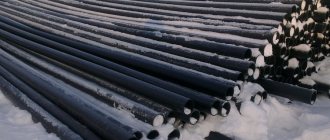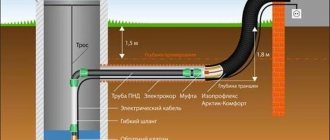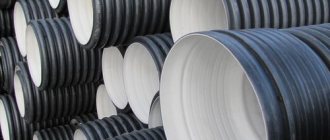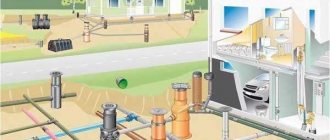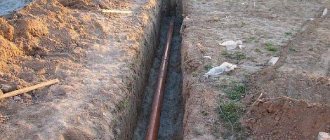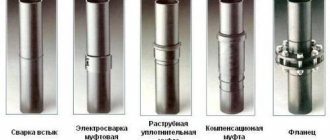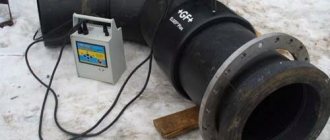Most of all pipelines laid in cities date back to Soviet times. The deterioration of heating mains, sewerage, gas and water communications reaches 70%, which is due to the material from which the pipes are made. This is steel that is subject to intense corrosion. The construction of gas pipelines from polyethylene pipes is becoming more in demand today. As the service life expires, many accidents occur on various pipelines: pipes break under high pressure, numerous leaks form, which lead to significant water losses. Performance indicators deteriorate: by reducing the cross-section of pipes, their throughput is reduced, the water becomes polluted, and its biological indicators decrease.
Structure of polyethylene pipes.
Advantages of polyethylene pipes
Pipes made of polyethylene (PE) are a modern alternative to their physically and morally outdated metal predecessors. They have a number of undeniable advantages compared to products made of steel or cast iron.
- No corrosion, which minimizes installation, maintenance and repair costs.
- Ease of use: polyethylene products are easy to cut, so they can be easily adjusted to size both on the construction site and in the field when laying pipelines.
- High throughput due to the fact that the inner walls of PE products are smooth.
- Polyethylene pipes have an elastic structure of the internal walls, on which scale does not form as a result and they are not clogged from the inside by various suspensions contained in the liquid.
- Polyethylene is chemically inert and successfully resists aggressive influences, therefore, it does not require additional special protection.
- Polyethylene is not electrically conductive, so it is not afraid of stray currents that destroy metal pipes.
- The bending radius of a polyethylene pipe can be up to 10 of its outer diameters, depending on temperature, which reduces the cost of connecting parts and facilitates the design and construction of pipelines.
- Polyethylene pipe has high flexibility: the minimum bending radius is 25 pipe diameters at 200°C.
- Significantly less weight compared to metal pipes, which makes installation and installation easier.
- PE pipes are resistant to temperature changes and have high sanitary and hygienic characteristics.
Scheme of deformation of polyethylene pipes depending on the type of soil.
Important note. Freezing of the soil leads to movement of pipelines in the vertical plane. These movements are uneven, resulting in deformations (bending). Predicting these conditions, it is necessary to determine how much the bending radius of a polyethylene pipe depends on the level of temperature reduction. In order to determine the bending radius, it is necessary to make special calculations. Or refer to special tables that indicate the minimum bending radius for a specific type of pipe.
The minimum bending radius of a polyethylene pipe is recommended by the manufacturer for each type and grade of pipe. If it is not possible to obtain the required bending radius, then bends, tees, etc. should be used.
Due to their technological and operational characteristics, polyethylene pipes are widely used: they are used in the construction of new pipelines and in the repair of old communications that have expired.
Carrying out internal sewerage
Recently, polypropylene pipes have become especially popular. They do not corrode, so their service life is much longer than pipes made of steel and cast iron.
And installing polypropylene pipes is not that difficult. However, you need to take into account this fact: how many sources of drainage are there in the house.
For those houses where many plumbing fixtures are installed, a pipe with a diameter of at least 100 mm will be required. Consider this fact: when leaving the washbasin, the pipe has a diameter of 50 mm, so you will have to join pipes of different diameters.
But today this is not a problem - there are special adapters. Therefore, you don’t have to worry about sealing the joints - it will be reliable.
It’s a good idea to check the quality of the gaskets: they should not be damaged. Then there will be no leaks at the joints.
Connecting plumbing fixtures
As a rule, the riser is equipped with an inspection (it is installed from the floor at a height of at least 1 m) and a special exhaust pipe (it is installed 0.7 m above the roof of the house).
Why is such a complex riser design needed?
Connecting a private home to a sewer system involves the formation of gases and an unpleasant odor.
If the riser is equipped with reliable ventilation, then this is a guarantee of ventilation of the entire sewer system in a private house.
Essentially, polluted air is forced out through the riser. And the people living in the house do not suffer at all from the unpleasant odor.
Important: insulate the riser if it is located in an unheated room. In order to connect the riser to the external sewer, you need to use a special outlet, its diameter should be smaller than the diameter of the pipe on the riser
Experts recommend installing the outlet to the riser along the movement of dirty water at an angle of 90 degrees or more. To connect the risers, two bends with an angle of 135 degrees are used.
In the case when another additional riser is required, then you need to use an oblique tee with an angle of 45 degrees and another additional outlet.
Therefore, it is much easier to connect to the sewer system of a private house yourself if there is one riser or one collector pipe.
For laying external sewerage, a polypropylene pipe with a diameter of 150 mm is best suited.
Sewer fittings
For those who still doubt their own abilities, we recommend watching: how to make a sewer system in a private house video. We hope that all your doubts will disappear and you will get to work with enthusiasm.
Scope of application of polyethylene pipes
Polyethylene products are widely used in modern construction.
They are used in the construction of water supply, sewerage, and gas pipelines. PE pipes are used in pressure and gravity sewers and serve as protective cases for electrical and telephone wires.
Old networks are being reconstructed using polyethylene pipes. Replacement can be carried out with the destruction of worn-out communications, but it is possible to lay new ones in parallel with the old ones, which does not require stopping the water supply to the population and blocking the sewerage system. Reconstruction of wells and other communication and plumbing structures depends on the degree of their deterioration. Individual parts (necks, shut-off valves, etc.) may be subject to partial replacement; if necessary, major repairs are carried out with complete replacement of pipelines.
Unloading and storage of PVC sewer pipes
Installation of PVC sewer pipes begins with unloading the resulting pipes and fittings and organizing their careful storage. Any pipe after transportation must be checked for defects
Unloading of pipes, either manually or using machinery, must be carried out with great care to avoid damaging them.
When unloading, it is unacceptable to throw frozen PVC pipes onto the cold ground or floor. The pipe should never be thrown at all, although PVC pipe is quite flexible, if not handled correctly it can crack even in warm weather. Moreover, a crack may be invisible, but during operation of the pipeline, it can cause leaks.
Installation of polyethylene pipes for sewerage
Sewage networks are internal and external. Their purpose is to collect and transport sanitary and storm water, which has a different chemical composition. Any problems in the sewer system dramatically affect the quality of life.
Elements and assembly for polyethylene pipes for internal sewerage
Polyethylene pipes for sewerage began to be produced not so long ago, and today they fully meet high requirements due to their inertness to the effects of mineral acids, alkalis and other aggressive substances. PE sewerage pipes have high throughput due to the absence of internal roughness. When installing external sewerage systems, frost-resistant PE pipes are used. Installation of internal sewerage does not require pipes with such high performance characteristics.
Sewage pipes are attractive to specialists working on the installation of such systems because their installation is much simpler compared to traditional sewer networks. Installation of internal sewer lines when using polyethylene pipes does not require complex special equipment. Small diameter polyethylene pipes are mounted using compression fittings.
External sewerage equipment is produced using the butt welding method: special welding equipment allows installation, reducing the number of joints up to five times in comparison with metal sewer pipes
The main types of autonomous sewerage for a country house
Despite the fact that many consider cesspools to be a thing of the past, this type of autonomous sewage system is the easiest to build with your own hands.
An equally important argument in defense of cesspools is the fact that their internal arrangement has now changed.
Before you make a sewer system in your house like a cesspool, you need to find out the engineering and geological features of your site.
The easiest way to build the walls of a cesspool is from brickwork, with red ceramic brick being the most acceptable option.
If it is possible to use additional equipment, then you can build a cesspool from reinforced concrete rings. Experts recommend concreting the bottom of the cesspool, covering the pit with a slab with ventilation and a special inspection hatch.
Septic tank made of polypropylene
Are you still undecided on how to make a sewer system in a private house yourself?
We recommend installing a local autonomous sewage system, for example, a septic tank.
This type of sewage system is especially relevant in those houses where people constantly live, and has gained particular popularity among Russians.
The septic tank is quite simple and reliable to use; it can be easily installed on your own by following the step-by-step installation guide (it is included when purchasing a septic tank, for example, their polypropylene).
In addition, septic tanks do not require frequent cleaning, so you will spend less money on calling a sewer truck.
Modern septic tanks are even three-chamber; they have a very high degree of purification of wastewater and domestic water thanks to elements of the aeration system and biofilters.
Sewerage in a private house video will help you decide which type of autonomous sewer system is most suitable for your home and site.
Sequence of actions during the construction of an individual sewer system
Before making a sewer system in the house, you need to decide on the initial steps:
Determine the area where the sewer well (cesspool or septic tank) will be located.
Important: the drainage well must be located below the level of the house. Determine where the sewer exits the house. Carefully inspect the exit point of the collector pipe. Please note that at this point all drains and used water from all plumbing fixtures in your home will accumulate (kitchen sink, toilet, bathtub, boiler). Inspection of the place where water enters from the entire house is necessary in order to to ensure that the collector is installed correctly (there should be no distortions or deviations). Only after a preliminary inspection has been carried out can a preliminary design for the sewer system of a private house be drawn up. Please note: the external sewer system is usually straight, the internal sewer system usually has many bends and angles. Therefore, when drawing up its project, it is very important to calculate all the dimensions of the pipes, their bends, and so on. Only after everything has been thought out and calculated can you begin to purchase the necessary materials. We begin the installation of external and internal sewerage systems.
Connection of water supply polyethylene pipes
PE products are connected in three main ways:
- contact butt welding,
- sleeve welding with embedded electric heaters
- installation using compression fittings.
A detachable connection is also possible, which is carried out using steel clamping flanges. Installation of pipeline turns and branches is carried out using welded or cast fittings.
Types of welding of polyethylene pipes
Different connection methods are used depending on operating conditions. If there are conditions for placing welding equipment, then butt welding is necessary. Butt welding is used when working with large diameter pipes (from 630 mm).
Limited working space (wells, chambers, trenches) requires electrofusion welding using embedded heaters.
If it is necessary to connect pipes with a diameter of up to 63 mm, compression fittings are used, which creates detachable structures. This connection is easy to operate, has high performance indicators, and does not require complex special equipment. The connection of internal pipeline systems is most often carried out in this way. Their installation is accessible even to non-professionals.
Construction of an external sewer system
If the internal sewerage system of a private house is practically no different from the sewerage system in an apartment, then the scope of work in the first and second cases differs significantly.
There is much less work to do if the house already has an old sewer system. In this case, you just need to dismantle the old pipes and use the same sewer paths as before.
But it may happen that you have to completely redo everything. In this case, there is a lot of work ahead: you need to raise the floor (spread it) and if the depth of the sewerage outlet from the house is not sufficient, we deepen it.
To do this, we dig a hole under the foundation, then measure the distance from the bottom edge of the foundation to its top edge.
This distance should be 1 meter or more, then the drains in the collector pipe at the exit from the house will not freeze, even in the Russian winter.
From the outside of the house we also dig a trench to the drain well. Moreover, experts recommend digging a trench deeper on the street than inside the house, and ensuring its constant slope.
This measure is necessary to ensure the unimpeded flow of water and wastewater.
Pipe laying
Laying polyethylene pipelines is carried out in two main ways. These are traditional laying of pipes in an open trench and trenchless laying - a method of deep directional drilling.
Using the open method, polyethylene pipelines are laid in a trench, the width of which is determined by the need to create working conditions. Water supply and sewerage equipment requires a trench width 40 cm greater than the outer diameter of the pipeline. These parameters are most often specified in the project. Long polyethylene pipes are often laid in a trench dug using a narrow-section chain excavator. In this case, the width of the trench decreases.
Types of laying polyethylene pipes.
The trench must be properly prepared. Its arrangement depends on the condition of the soil. If the bottom of the trench is hard and dense, then a cushion is needed. The bottom is covered with a layer (about 10-15 cm) of sand or other granular material and leveled. At a distance of 2 meters from the inspection well, the pillow is compacted. There should be no stones or lumps of frozen soil at the bottom. When working with loose soil that is at risk of displacement, it is necessary to strengthen the bottom. In such cases, the bottom of the trench is strengthened with geotextiles.
If the trench bottom is level and has optimal soil characteristics, a cushion is not needed. You can get by with a small excavation of earth at the base of the pipe to its width and replace it with a softer one.
Factors that determine installation depth
When choosing the depth of pipe laying, it is necessary to take into account a number of factors that have a significant impact on this value and, accordingly, determine the cost of installation work.
- Purpose of the sewer network.
- Method of laying sewerage.
- Climatic conditions in the region.
- Possibility of additional load on the sewer pipe.
Let's look at these criteria in more detail.
Types of sewer networks
For most ordinary people, sewerage is associated only with the removal of sewage from residential premises, but in fact, the concept of sewerage is more extensive and includes various networks.
Storm drainage system
- A storm drainage device is designed to collect and drain atmospheric precipitation. The depth of the storm drainage system should not be less than the depth of soil freezing. When insulating the system, it is possible to reduce the depth to 0.7 meters.
- Cable ducting is designed to ensure the safety and possibility of replacing electrical lines. Laying electrical cables in special pipes greatly simplifies the installation process. The depth of the cable duct is determined mainly by the material of the pipes from which it is made. When using plastic pipes, it should be at least 0.4 m, and when using steel sewers - 0.2 meters.
The depth of laying a domestic sewer depends on a whole range of factors, which we will consider below.
Backfilling the trench
The soil removed during the construction of the trench, which does not contain 20 mm stones, is used for primary filling. It is made along the entire length of the pipe, about 15 cm high from its top. If it is necessary to compact the fill, the soil must meet certain requirements. You can use fine gravel (20-20 mm) or crushed stone (4-44 mm). Soil must not be dumped directly onto the pipeline. The pipeline laid at the bottom of the trench and sprinkled needs to be compacted. The filled soil is compacted in layers of 20 cm on both sides of the pipe so that it does not move. The soil is not compacted directly above the pipe.
Backfilling is carried out after compaction and a compacted layer of about 30 cm on top of the pipe. The trench can be backfilled with extracted soil; the size of the largest stones is allowed no more than 300 mm. Even with a layer of protective pavement about 30 cm thick, the size of the stones in the soil used for backfilling cannot be more than 60 mm.
Stages of laying external sewerage
Many people, thinking about installing sewerage into their home, wonder how to lay sewer pipes? The whole process can be divided into several stages:
- Drawing up a plan for the future sewer system and calculating all the necessary materials that will be needed to install the system. Here, not only the required length of pipes is taken into account, but also all the necessary corners, transitions and branches that may be needed are calculated.
- Carrying out all earthworks.
- Installation of the entire pipeline.
- Carrying out backfilling.
This instruction will help you lay a sewer system in a country house or cottage without any unpleasant surprises, since all possible cases have already been calculated at the planning stage, and thus you have nothing to fear.
Trenchless pipeline laying
Scheme of trenchless laying of polyethylene pipes.
In some cases, when pipeline lines intersect with a railway, busy highway, river or other obstacle, laying an open trench is not possible. The reason may also be the need to minimize the cost of digging a trench. This is the basis for using the method of trenchless laying of polyethylene pipelines. The method of trenchless installation of horizontal directional drilling (HDD method) has become widespread.
Horizontal drilling is a special method of installing communications without opening the soil. Work begins at the point where the pipe comes to the surface. The technology guarantees high accuracy of drill placement at the intended location of reaching the surface. The method makes it possible to lay underground pipes with a length of more than 100 m and a diameter of up to 630 mm or more. There are two main methods of horizontal drilling: guided and unguided.
Controlled horizontal drilling is carried out by tunneling machines, through flushing and pilot drilling.
Uncontrolled horizontal drilling is carried out using two methods: 1) without casing (ram drilling, displacement drilling, auger drilling) and 2) with casing (drill injection, puncture drilling, impact drilling, ram drilling).
Horizontal drilling methods and trenchless laying of polyethylene pipes are considered the most modern technology. To enlarge the well, a special drilling enlargement is used. To improve the drilling, the well is treated with a drilling clay mud, which forms and lubricates the channel itself.
Thus, the characteristics of polyethylene products allow them to be installed and laid using any currently known method, taking into account the restrictions imposed by the minimum permissible radius of their bending.
A pulled or pushed polyethylene pipe is able to repeat the configuration of the old route, which has a radius of curvature of more than 120 diameters of the pipe itself. Metal products practically do not have such a bending radius.
Scheme of sewerage supply to the house
As you know, there are three types of sewer network arrangement schemes, namely:
Scheme of sewerage supply to the house
- Centralized type, which involves connecting the outlet from the house to the general highway.
- An autonomous type without pumping, which involves connecting the house to a septic tank for collecting solid waste and subsequent installation of a drainage system for settled water. In this case, the soil of the site is responsible for filtering the discharged water.
- Autonomous type with pumping, involving the collection of wastewater in a large storage facility, released by periodic pumping out of settled water. Moreover, the pumping of such water should be carried out by a special company that provides sewage disposal services.
And all sewerage schemes require an original plan for laying and connecting sewerage to the house.
Sewage arrangement diagram
Thus, in the case of a centralized wastewater collection scheme, the laying of sewer pipes in the ground is carried out from the central outlet of the sewer pipe of the internal network to the entrance to the collector of the central network. Such a pipeline is laid in one line and is supplemented with inspection wells, where dampers and revisions are installed to facilitate system maintenance.
In the case of installing an autonomous system without pumping, the laying of external sewerage networks is carried out in one line from the outlet of the waste pipe to the entrance to the storage facility. The pipeline is equipped with revisions and dampers.
In the case of installing an autonomous system without pumping, the sewer pipe is pulled from the sewer outlet to the septic tank, from which the drainage pipes are diverted. This is the most labor-intensive option for eyeliner, but also the cheapest to maintain.
Organization of installation work
Welding and installation work with polyethylene pipes is carried out either according to the basic scheme or by the route method. The basic method is used in cases where the facility is located near the welding site, where the pipes are pre-connected and then transported in finished sections to the pipeline route. The length of the section can reach more than 30 m. On site they are welded into a single thread, which must then be carefully laid in a trench so as not to disturb the bending radius.
Route welding begins with laying pipes along the trench. Then installation and welding is carried out using mobile welding units. Small diameter pipes can be laid in the trench manually. However, pipelayers or cranes are most often used. The finished thread should be lowered without jerking, evenly, having previously secured it with hemp ropes or soft slings, which should be located at a distance of 5-10 meters from each other. The solid welded thread must be lowered into the trench carefully so that the critical bending radius is not exceeded during installation. You should first wait at least 2 hours after welding the last link.
Sequence of operations when laying large-diameter pipes in a trench
Products intended for pipelines are checked twice:
- Manufacturing plant.
- Before laying in the trench.
Important! During the inspection, all pipes that have cracks, bubbles, chips, foreign inclusions and other defects that jeopardize the trouble-free operation of the system are rejected.
Only small-diameter pipes are laid manually, with the help of simple devices, or with the use of small-scale mechanization; in other cases, the use of cranes is required. Lowering a pipe or section into a pit is a labor-intensive and slow process, which affects the timing and cost of the work performed. The use of large-sized fasteners containing:
- vertical panels;
- horizontal purlins;
- spacer frames spaced 3-3.5 m from one another.
When using large-sized fasteners, one of two installation schemes is used:
- In two streams. First, the pipe is laid by installers using a crane to the bottom, its position is finally verified and temporary fastening is performed. Then another group of installers caulks the joints using a compressor and pneumatic hammers.
- In three streams. Laying, welding, position alignment and temporary fastening of two pipes at once are carried out separately using two cranes. The third thread performs caulking of the joints.
Laying a main line consisting of one branch is carried out in two streams
Fixing is done by adding soil or using wedges. The joints of non-pressure pipes are sealed with tarred tow or asbestos-cement mixtures; pressure pipes are sealed with rubber rings or cuffs. The connections of steel products are welded, and those of polymer products are glued and welded.
Disadvantages of polyethylene pipes
Problems with polyethylene products are related to the characteristics of all viscoelastic thermoplastics. Their strength largely depends on the degree of bending and compression, and in general it is relatively small. Polyethylene is sensitive to ultraviolet radiation, which has to be compensated for by adding coloring additives (usually carbon black) and using protective paint. The thermal expansion of polyethylene is quite high and has to be compensated for using a structural L- or U-shaped bend of the pipe.
Today, domestic underground pipelines have a length of about 2 million km. These are mainly steel pipelines. For example, polyethylene pipes account for about 10% of the total length of gas pipelines. Other networks also do not have very high scores for this parameter. However, there is a strong tendency that modern pipelines are changing in percentage in favor of polyethylene pipes.
Classification of pipeline laying methods
The installation process largely depends on how the pipeline system is laid. There are three main installation methods depending on the location of the pipeline:
- Overground.
- Underground.
- Underwater.
Laying methods are also chosen depending on the influence of factors such as:
- soil structure;
- pipeline diameter;
- methods of work;
- intensity of transport links.
The combination of the influence of the listed factors determines the method of laying the pipeline:
- Open.
- Hidden.
- Closed (trenchless).
The choice of pipe laying method is influenced by many factors; soil structure is of great importance
Advantages and disadvantages
Advantages of using polyethylene sewerage systems:
- Durability. When laid without exposure to ultraviolet radiation, you can count on 50 years of operation.
- Durability, resistance to crushing.
- Plasticity, tear resistance.
- Resistance to aggressive wastewater, corrosion, biological pollution, chemical inertness.
- Harmless to humans.
- Frost resistance. Polyethylene pipelines can withstand freezing with liquid inside, and after defrosting they return to their original shape.
- The pipeline does not become overgrown with calcium and magnesium salts from the inside.
- The smooth inner surface facilitates faster evacuation of contents.
- Low weight facilitates transportation and installation.
- The industry produces fittings of any shape and purpose. From bell-shaped or corrugated polyethylene products, you can easily assemble a sewerage system of any shape.
- Installation is quite simple and does not require highly qualified installers.
- Bell-shaped communications and pipelines on couplings with collet clamps can be disassembled and reassembled if necessary, pressure welded pipelines can also be used after disassembly (the sections will simply have to be increased).
One of the most significant advantages of polyethylene is its price. This is the most inexpensive plastic.
A serious drawback of polyethylene products is their instability to ultraviolet radiation. But for underground sewerage this drawback does not matter. In addition, polyethylene has a high coefficient of thermal expansion - during summer installation it is necessary to provide a small margin in length so that in winter the cold and reduced pipe does not experience stress.
Polyethylene seems to have been created for underground installation - this material has some advantages and no disadvantages at all.
How to seal pipe connections
The tightness of the HDPE pipe system is ensured using rubber seals. When laying an underground pipeline, it is necessary to ensure its additional sealing at the socket joints. This is dictated by the difficulties in identifying a malfunction and repairing the system in the event of leaks or groundwater entering it.
Silicone sealing
Polymer sealants are used to seal joints. The most popular of them is silicone, which contains rubber. In working condition, this material has good elasticity, a high degree of adhesion and can withstand heavy loads.
On the market you can choose a sealant for specific operating conditions of sewer or water supply systems.
Sealing pipes with silicone
The compound is applied without gaps to the inside of the socket and the outer section of the pipe being joined to it, and after the connection it is necessary to lay the sealant around the entire circumference and to the outer part of the joint. The seam is smoothed with a soft spatula or a moistened gloved finger.
Important! After joining the pipes with silicone sealant, it is necessary to ensure that the joint areas remain motionless for at least 4-6 hours.
Sealing with self-adhesive tape
Self-adhesive tape is effective for sealing pipeline turning corners, plugs, taps or bends. Its composition includes bitumen-polymer materials, which ensures complete waterproofness.
- Prepare areas of pipe connections by cleaning them from dirt and treating them with a primer.
- Wind the tape under constant tension with a 50% overlap over the joint area, avoiding folds and distortions.
READ ALSO: Do-it-yourself stripping for polypropylene pipes, stripping tools, options
The tape is applied to a dry surface with a mastic layer inward in a spiral.
Sealing self-adhesive tape
Advantages of sealing tape:
- long service life with preservation of tightness - more than 30 years;
- avoiding deformation when applied correctly;
- mechanical strength and resistance to chemicals and soil corrosion.
To seal the communication route in the ground, it is better to use winter tape with the letter “Z” in the marking.
Installation of country water supply
Connecting PE pipes with compression couplings is easy and accessible even for a non-professional :
- The pipes are cut evenly with a special pipe cutter or a hacksaw with a fine tooth.
- The cut area is cleaned and a small chamfer is removed from it.
- The dismountable coupling parts are put on the pipes in strict sequence, the ends of which are then inserted into the central part of the fitting and tightened securely.
This illustration clearly shows how to assemble and connect polyethylene pipes for water supply.
Gone are the days when water from a well in a dacha had to be carried into the house or garden in buckets: the modern construction market offers water supply products and systems that are affordable, practical and convenient for self-installation.
What do you think of this article?
Possible problems when laying polymer pipes
Laying polymer pipes using the trench method seems to be the best choice when constructing a pipeline. If you need to carry out work in an area where the soil is too hard and laying a trench is difficult, you should, if possible, wait for weather conditions with high humidity. A similar effect can be achieved by moistening the soil at the installation site.
In loose soil, the puncture method is used for underground pipe laying.
Laying a pipeline in loose soil is accompanied by constant soil shedding. This can lead to deformations in the system and its failure to operate. Therefore, it is customary to strengthen loose soils using, among other things, special geotextiles. Another way out of this situation is to use the puncture method. Then a pipe made of polymer materials will be placed inside a steel pipe previously laid as a protective casing.
Good to know! The trenchless installation method has to be resorted to when some large object gets in the way of the pipeline. In this case, polymer structures can be additionally insulated with a steel casing.
What do we know about them
- The material can withstand standard pressures for water supply networks, as well as temperatures up to 95 °C if the flow is constant, and about 110 °C with short-term fluctuations.
- If the water in the pipe freezes, the product will not burst, like a metal one, but will remain intact and unharmed. This is due to the property of polypropylene to expand simultaneously with the frozen environment and return back after thawing.
- You can assemble a summer water supply system at your dacha from polypropylene pipes, create a system for supplying cold and hot water to the house from a central water supply or boiler, and use products to supply coolant in the heating system to radiators.
The cost of installing a water supply system made of polypropylene pipes depends on various factors. If you don’t want to pay specialists, do it yourself, especially since this work is not difficult.
Polypropylene pipes are of the following types:
| PN10 | Used to transport cold water. |
| PN16 | The products are used for hot and cold water supply systems. |
| PN20 | Most often this type can be seen when installing hot water pipes and heating systems. |
| PN25 | Typically, this option is used in heating systems for homes and industrial premises. |
Advice: since products PN10, 16, 20 and 25 increase their linear dimensions with increasing temperature, we recommend installing them with sliding supports and various compensators.
Reinforced PP pipes are used in heating systems for homes and industrial buildings. Their linear elongation at a temperature of 60˚C is significantly less than the elongation of similar products of previous types. Their price is higher than non-reinforced products.
Diameter
When you decide to install a water supply system from polypropylene pipes with your own hands for a house or apartment, you need to decide on the diameter of the products. For example, the most popular sizes of polypropylene water pipes are 20 mm, 25 mm and 32 mm. We recommend selecting them, taking into account the diameters of the nozzles of your soldering iron.
There are other sizes - ØØ 40 mm, 50 mm, 63 mm, 75 mm and 90 mm. For a sewer pipe, a common diameter is 110 mm, but not all standard soldering irons may have such nozzles.
Advice: we recommend that you first purchase a soldering iron and only then begin to select the appropriate diameter for the water supply and heating systems, based on the size of the available nozzles.
The cost of laying a water supply system from polypropylene pipes depends on the depth of the trench, the length and complexity of the work. You can save a lot of money if you do everything yourself.
Installation of water supply
The laying of a water supply system from polypropylene pipes is carried out after calculating all the necessary parameters and selecting equipment for the work.
The process follows the following sequence:
- Remove the old pipeline.
- Cut the pipe sections to the required length based on the diagram presented.
- Install connecting couplings at the ends of the products if polymer pipes need to be connected to steel fittings or lines.
- Weld the reinforcement elements using the polyfusion method.
- Install shut-off valves.
- Make channels in the walls for pipes or make holes for mounting fasteners.
- Install the PP pipes for the water supply in place.
Features of the installation process
- To connect PP pipes to metal network elements - mixers, steel lines, filters or meters, use fittings with metal inserts.
- During connection, the threads must be sealed with plumbing fum tape , and the tape edge should be turned in the direction of twisting when clamped.
Advice: do not make the winding layer too thick; just two turns will be enough. Also, do not over-tighten the threaded connection or you will damage the fitting and rip the metal insert out of the body.
- To create a bend, use corner fittings or heat the pipe to 140˚C using a hair dryer . Keep in mind that polypropylene can catch fire if it comes into contact with fire.
- The expansion of polypropylene directly depends on the temperature of the working medium passing inside the pipes . Therefore, do not forget to provide for the latter a free distance of 10 mm near the bends or tees for thermal expansion.
- During installation, it is necessary to make a groove in the wall of such a diameter that you can put insulation on the pipe and leave a gap around it.
- When choosing polypropylene products for heating or hot water supply, remember that they must have a metal braid inside . Thanks to this design, it is possible to reduce their thermal expansion by almost 5 times. For cold water supply, thermal compensators are not needed at all.
Advice: although PP pipes can easily withstand freezing, metal shut-off valves and network elements do not allow it. Because of this, we recommend not to neglect draining the water when the cold season begins.
Soldering technology
The work is not difficult, but it requires concentration and accuracy, otherwise you will have to redo everything again, and the damaged place cannot be restored.
The work instructions are as follows:
- At the first stage, install nozzles of the required diameter into the soldering iron. As mentioned above, pipes are selected based on these parameters. Arrange them as you wish, the main thing is that it is convenient for you. It doesn't really matter.
Tip: You can only clean the nozzles with a wooden scraper, because they are coated with a non-stick Teflon layer.
- Set the operating heating temperature on the soldering iron to 260˚C. It will warm up to it in about 7 minutes, after which the device will constantly maintain it.
- Cut the pipe to the required length at a right angle with your own hands.
- Place both the fitting and the pipe onto the already heated nozzles at the same time.
Advice: do not rush, since the heating time of the products depends on their diameter; the larger the diameter, the longer the process should take.
Place the pipe in the nozzle to heat it from the outside, at the same time put the fitting on the steam nozzle and heat it from the inside.
- Remove the parts after they have warmed up, insert them into each other and fix in this position for 100-120 seconds. At this moment, it is prohibited to rotate or move the parts relative to each other.
- If the parts are not fixed as desired, the ends should be cut off and soldered again.
Related article: Bringing water to a private house
This technology for connecting PP elements together is unlikely to become a stumbling block for a home craftsman. The main thing is to follow the sequence of actions and accuracy when performing them.
Open way
The open method of laying a pipeline cannot be called a popular solution. Rather, it is a compromise that is relevant in cases where installation using a closed method is impossible.
Stages of work:
- preparing and leveling the trench for laying the pipeline ;
- strengthening the walls and bottom of the mine;
- sand cushion mound;
- installation (assembly) of pipes;
- covering pipe sections;
- closing the trench;
- leveling the surface and restoring the coating (if any) of the landscape object.
An open network can also be established in non-passable channels. Then the main pipes will not be subject to constant mechanical stress (pressure) during periods of soil movement and heaving. True, repairs are difficult due to less comfortable access directly to the sections.
The advantages of open underground pipeline installation include the possibility of its implementation in cases that exclude the hidden installation method. Minuses:
- high cost of the project (the need to carry out labor-intensive excavation work and restore the landscape);
- mandatory break in the operation of facilities along the route;
- creation of emergency zones at the site of soil opening.
We lay a highway from HDPE pipes
If you decide to install a pipeline for the delivery of hot, cold water or gas in a private house with your own hands, follow our recommendations!
Preparing a trench for laying HDPE pipes
- Develop a pipeline construction plan, put it in writing, draw up diagrams for laying a pipeline made of polyethylene pipes.
- Mark the ground around the perimeter of the construction site.
- Dig trenches with a depth of slightly more than 2.5 m (for a long route it is better to rent special equipment) and a width sufficient for convenient work (there are no strict standards, but it is recommended to create a distance of 40 cm between the pipe and the walls of the trench).
- When forming a trench, it is important to maintain a slope angle of 1-2 degrees per meter of length.
Important! When determining the optimal depth for laying pipes, take into account, on the one hand, the level of soil freezing, on the other, future maintenance of the system and the need for insulation (if you have to make a trench closer to the surface).
We lay HDPE pipes in the ground
Do-it-yourself pipe laying underground is done from the point of the fence (connection to the central system or well) towards the house. The prepared pipes are laid along the trench. The sockets and ends of the pipes are cleaned, a mark is set for the maximum depth of the pipe entry into the connecting part, the socket. Then the pipes are assembled - joined with a gap (if not end-to-end), which makes it possible to compensate for spontaneous deformation of the pipeline. Trenches can be insulated using foamed polyethylene if the laying of HDPE underground must be carried out at least below the freezing level of the soil. Next, sealing is performed.
Sealing of HDPE pipes
To ensure obstruction of the medium transported through the pipeline outside the pipe, special seals are used at the joints. Sealing also prevents groundwater, soil and microorganisms from outside from entering the system.
Silicone sealing
Silicone sealants have a liquid consistency. Suitable for connections in pipelines under pressure, withstand heavy loads. After applying to the contacting parts of the elements to be connected (pipe and socket), a reliable plastic gasket is formed on the joint from the outside after combining the two parts and drying. The existing range on the market is focused on different operating conditions.
Important! The connection treated with silicone sealant must be fixed motionlessly for 4-6 hours until completely hardened.
Sealing with self-adhesive tape
It is used for any threaded connections of pipelines, including for open laying of HDPE pipes, in places of turns, bends, and plugs. The technology provides complete sealing for more than 30 years, thanks to the bitumen-polymer substances in the composition. The tape is resistant to aggressive soil composition and corrosion. In the presence of vibrations, displacement, and other forms of route movement, the quality of the sealant decreases. It is easily applied to a cleaned and primed connection - evenly, with tension and overlap, to prevent displacement during operation of the pipeline.
Thermal insulation of HDPE pipes
When laying a polyethylene water pipeline, thermal insulation is necessary if the depth of the trench is less than the depth of soil freezing (less than 1.4-1.6 m).
Important! Given the described installation features, it is better to provide thermal insulation in regions with traditionally warm winters, in order to prevent damage to the pipe in the event of unusual weather conditions.
Among the thermal insulation materials: mineral wool, mineral wool cylinders, covers made of foamed polystyrene, polystyrene foam, rubber, polyurethane foam and PPR shells, etc. All of them have minimal thermal conductivity, are hygroscopic, and resistant to high temperatures.
Thermal insulation can be done with your own hands. The laying process depends on the chosen technology. For example, there is polyurethane foam insulation in the form of a pipe shell (shell) no more than 80 mm thick. This design is assembled from several sections, overlapped (the width of the overlap is not less than the diameter of the pipe). Attached to the pipeline using couplings, clamps, and glue to ensure a tight fit. The assembled casing is covered with foil or other material that increases its effectiveness. Thermal insulation using polyethylene foam is performed using self-adhesive aluminum tape, which consists of foil on one side and a layer of glue on the other.
Air pressure testing of pipelines
Pressure testing is carried out on a small section of the route in order to test the system for operability and tightness under conditions close to the maximum pressure (twice the working pressure). Thus, the integrity of the pipes and the reliability of the connections are monitored. Typically, water is used as the high-pressure transport medium, which makes leak detection easier. But if this is not possible, then air pressure testing is performed.
Monitoring the integrity of the route is necessary when using any technology for laying HDPE pipes. This must be done before putting a new pipeline into operation or after repairing a section or cleaning pipes. It is especially necessary if the connections are made using the coupling method.
To carry out the work, the controlled section of the route is closed using special plugs or by closing valves. A device that creates pressure is connected (a pump used to circulate the medium in this pipeline, or a special pump for pressure testing). The equipment is selected in accordance with the volume of the area being tested. Using a pressure pump, air is pumped in with pressure controlled by a measuring device. When the limit value is reached, the blower is turned off, the value is recorded on the measuring device and compared with the same value after 6-7 hours. The tightness of the area will be confirmed by the absence of a difference between the initial and last indicators.
Important! Even during the design of the pipeline, a special outlet should be provided for connecting the pump performing pressure testing.
Closing the trench
After laying the water supply system from polyethylene pipes, the trench is covered with soft, clean soil. You can use the soil extracted when digging a trench, but it must be cleared of stones with a diameter exceeding 3 cm. If the soil is not suitable for backfilling, sand or gravel with a fraction size of no more than 20 mm is used.
The earth is poured into the cracks between the walls of the trench and the pipe with periodic compaction of the layers (every 20 cm). The surface should be kept horizontal. If the soil is too loose, the laying is compacted with thin layers of crushed stone or gravel. The pipes are backfilled last without compaction or applying pressure to the backfilled soil. The height of the layer on top of the pipe should be 15 cm or more.
Important! If you compact the soil in a trench excessively, you can reduce the diameter of the pipe, push through or break the surface.
Correct implementation of trench closing technology is of great importance, so it is important to choose the optimal backfill material and organize the bottom so that it provides support for the highway. If all requirements are met, then this installation option ensures a long service life of the pipeline compared to external installation.
Possible difficulties and advice from experts
When underground construction of a polyethylene highway, you may encounter some difficulties. These include:
- soil characteristics (stoniness, unsteadiness, humidity, swampiness, heaving);
- high location of groundwater;
- location of other underground communications along the route.
Therefore, before starting work, it is necessary to conduct the necessary research and take everything into account at the design stage.
Experienced professionals also advise:
- tighten fittings with care, without excessive force;
- the discrepancy in the cross-section of welded pipes should not exceed 10%;
- Butt welding of polyethylene products should be done with one seam.
Following the advice given and following the technology for constructing communications from HDPE pipes will ensure the reliability, functionality and long-term operation of engineering systems.
Installation of an external pipeline: step by step
1. Extracting a trench to a depth of 0.3 – 0.5 m below the freezing level.
2. Add 7-10 cm of sand cushion, pour water and tamp (once, instead of sand, due to its lack, we used broken tiles; today - 2015 - the water supply system has been working properly for 16 years).
3. Laying the pipe itself. Which pipe should I choose for entry? You can use polypropylene (it’s stiffer), or you can use 25 or 32 mm polyethylene (15 mm is not enough). however, this has been said above and sufficiently justified.
4. Hydraulic testing of the pipeline with a pressure 1.5 times greater than the operating pressure (tests can be carried out with air).
Related article: How to eliminate condensation on a cold water pipe
5. Fill with sand in a layer of 10 cm with careful (!), not very strong (!) tamping.
6. Backfilling the trench with soil.
A few parting words in case you (and most likely) entrust all or some of the listed work to any contractor that has a license or certificate allowing such work (connection to a central water supply, hydraulic tests, installation of a meter).
You can take on the task of digging out the trench, adding a sand cushion and backfilling, thereby saving some money.
Be sure to familiarize yourself with the estimate, which indicates the length of the pipeline, the volume of excavation work and the soil category (often they put category II or III, which corresponds to stony or rocky soil, which may not be the case in reality), since at these points contractors can “stretch “The estimate is in your own favor, of course.
In the next article we will look at installing an external water supply system if groundwater is close.
Insulation of the water supply system
In order to prevent pipes from freezing and to use the water supply all year round, it is necessary to take measures to insulate it. Materials that are resistant to fire and have low thermal conductivity are used as thermal insulation. If mineral-based fiber insulation is used, the water supply system should be additionally insulated from moisture, otherwise the insulation effect will be reduced to a minimum value. More convenient to use is polystyrene foam, which is produced in the form of shells of two semicircles, treated on the outside with a layer of waterproofing.
Insulation using expanded polystyrene
Particular care should be taken when insulating water pipes at the entrance to the house, since this section is most susceptible to freezing. To avoid such phenomena, in the area from the water supply outlet from the ground to the entry into the house, the pipe is wrapped with a heating cable, and a special sensor is installed to reduce energy costs. It monitors the pipe temperature and turns on the heating system at a critical value.
After insulation, plastic pipes for the external water supply are covered with soil, after a preliminary check of its functioning.
Laying concrete, reinforced concrete and ceramic pipes in a trench
Self-propelled assembly cranes and pipe layers are used to lay concrete and reinforced concrete pipes with a diameter of over 250 mm. To speed up the process, the products are pre-connected into sections (links) of 2-5 pieces. Fixing the horizontal position of the sections when lowering is achieved using a traverse.
At the intended connection, a concrete stop is pre-installed into the socket, onto which the first link is lowered. The pipes are fed by the crane with the socket forward as the installation progresses, and against the flow of the working medium.
Note! Docking is carried out using coupling and socket joints using sealing with rubber rings, tarred hemp and sealing with asbestos-cement mixture.
For seam joints of products with a diameter of 400-800 mm, cement mortar applied to the seams is used. For diameters exceeding 1000 mm, the entire perimeter of the joint is sealed with hemp strands and rubbed with cement mortar. On the outside of the joint, formwork is installed, reinforcing mesh is laid and cement mortar is applied.
Laying of concrete and asbestos-cement socket pipes is carried out with the socket forward
When sealing the joints of ceramic pipes, they sometimes resort to pre-installing rings of bitumen mastic on the inner surface of the socket and the outer surface of the smooth end. The surface of the conical rings is softened by applying a solvent or molten hot bitumen. In this way, a strong and tight cold connection is made.
Connection to the central pipeline
If we connect to the central pipeline, then we dig a trench from the well to the house:
Related article: Hydraulic compensator for water supply
- and lay the pipe:
The trench is dug from the well below the freezing depth of 0.3. 0.5 m, preferably with a slope of 0.03 (3%, i.e. 3 cm per meter) degrees towards the well. Shut-off valves are installed in the well, the type and diameter of which are indicated in the technical specifications. The connection to the central water supply is made by Vodokanal. And you can do the wiring in the house yourself.
To pass a pipe under the road, a water pipe is inserted into a sleeve - another pipe, but of a larger diameter, for example, polypropylene into steel or steel into asbestos, etc.:
For the sleeve, you can take a used pipe. It is necessary to clean the sharp edges of the pipe sleeve with a file, removing burrs.
If the pipe is laid below the freezing depth, then there are no more problems.
What to do if it is not possible to lay a pipe below the freezing depth, for example, due to close groundwater? The next article is about this, the link to which is at the bottom of the page, but still read this article, because otherwise the technology for installing an external water supply is the same for any groundwater level
.
